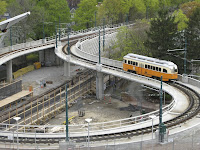
DORCHESTER – Reconstruction of Ashmont Station, the starting point of the Red Line T service, is about 50 percent complete, despite being about six months behind schedule, Mass. Bay Transit Authority construction officials said.
“A new schedule was made and updated when milestones were not reached, but the delay has not affected the overall schedule,” said Scott Kelley, senior project manager in charge of rebuilding Ashmont Station and renovating all Dorchester branches of the Red Line.
The entire $35 million project has been split into two contracts, one focuses on the structure and the other on the architectural detail. The first contracted is estimated to last three and a half years, while the second contract should only take 18 months, Kelley said.
 The entire project is expected to be complete in August 2009.
The entire project is expected to be complete in August 2009.The historic Mattapan High-Speed Trolley is operating after 15-months of interruption, having been replaced by buses. Fare collection and other operations in the southern end will begin in one month. As for the northern end, demolition begins in May. The Red Line has not stopped running due to construction.
“There’s a whole science to working around the trains,” Kelley said. “We have to sequence all the work around the every day operations of the MBTA.”
The south head house, or entrance, is erect and its roof is one-third complete, while the reconstruction of the High-Speed Trolley viaduct, a series of three bridges leading the trolley to the station, is already finished, Kelley said.
 “The trolleys are like antiques,” Kelley said. “There was a community outcry for the old trolleys to remain on the line.”
“The trolleys are like antiques,” Kelley said. “There was a community outcry for the old trolleys to remain on the line.”Postponing service to Ashmont Station during the reconstruction of the viaduct on the Mattapan line enabled the MBTA to also revamp the eight trolley cars with air conditioning, heat and handicap access under a separate contract.
Aside from a roofing job in the 1970’s, Ashmont Station had no substantial renovations since construction finished in 1928, said chief engineer Michael Kearney. The old station was 80-years old.
The new station will be roughly the same size as the old station, including the platforms, which are about 460 feet long, enough to fit six train cars. It will be been moved closer to Peabody Square, from which the old station could not be seen. There will be three elevators, two escalators and it will be equipped with state of the art surveillance and fare collection services.
The surrounding area has been modified to better accommodate the estimated 3-4,000 daily commuters, Kelley said. There will be a new bus lane for the 11 buses that stop at the station, in addition to new bus shelters. There will be a park leading up to the Station from Peabody Square. A chunk of the land has been contracted to Trinity Financial, Inc., a developer who has since put up a transit oriented, mixed income housing and business complex known as the Carruth building across the street.
The revitalization of business along Dorchester Avenue is part of a larger project of the Boston Redevelopment Authority, initiated by Mayor Thomas M. Menino.